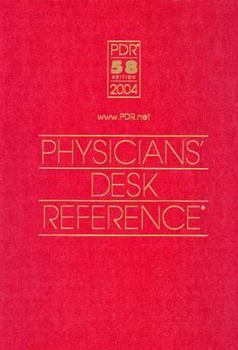Physician's Desk Reference
Physicians' Desk Reference: Hospital Library 2004 This description may be from another edition of this product.
Format:Hardcover
Language:English
ISBN:1563634716
ISBN13:9781563634710
Release Date:January 2004
Publisher:Thomson PDR
Length:3538 Pages
Weight:8.10 lbs.
Dimensions:2.9" x 9.3" x 12.3"
Related Subjects
Education & Reference Encyclopedias Medical Medical Books Medicine Pharmacology Pharmacy ReferenceCustomer Reviews
4 ratings
Does this mean they LISTENED TO US???
Published by Thriftbooks.com User , 19 years ago
The PDR has always been a uniquely important source. However, in various respects the format has been problematic, as some of us have noted. I assume we were not alone -- we were probably just a few voices among many. And happily, it looks like perhaps the publisher and its fellow parties have listened. In past reviews I noted the difficulty in finding certain sections -- for example, "Drug Interactions." I mentioned that boldface headings would be helpful. And I see that for at least the last couple of years, this has indeed been done. Bravo!! -- a very welcome improvement. (I have been slow to notice this change. My apologies!) But other problems remain. For example, side effects in most cases are divided between two or more different sections of each article. And various important things are still hard to find. How often have you wanted to find "half-lives" of a medication and perhaps its metabolites, and how often have you actually found them?? They are there, but they're buried. Something as important as this should certainly be highlighted in some way. The "Foreword" explains that the PDR is constrained in its content: various aspects are required to be "same in language and emphasis" as the approved labeling for the products (including such things as use of boldface). But look -- the boldface was indeed added where mentioned above. I imagine this means it was also done on the product-labeling, probably in response to many voices that were raised. Perhaps the publisher could add its voice to further the efforts along such lines. There are some seeming flaws that clearly aren't the fault of the publisher and are probably unavoidable. For example, despite the fact that seemingly anything and everything is mentioned as a possible side effect for every medication, common side effects sometimes are not mentioned at all. This reflects mainly failures of the medical literature, not a failure of this publisher, because if a side effect isn't mentioned prominently in the literature, understandably it might not find its way into the PDR. Secondly, oftentimes some major uses for a medication are not mentioned, but this reflects the absence of official approval for those uses. Some caveats for consumers: The listed dosage ranges for any given medication are sometimes too limited. Lower or higher dosages may be right for some people. And also, do beware of those endless lists of possible side effects. Remember that these aren't necessarily things that will happen; they only MIGHT happen. (Many of them rarely if ever are caused by the medications.) And sometimes the lists fail to include things that DO happen! If you are convinced that a medication has done something to you and it's not mentioned in the PDR, you still could very well be right. But, don't assume that something IS happening just because it's mentioned on that endless list! The improvements in this important reference are much appreciated. And there is clear room for fur
Standard
Published by Thriftbooks.com User , 20 years ago
There are a lot of drug reference books. Many, if not most, are quite good. It depends more on how you like your information organized than anything else. The PDR is not designed to be carried in your pocket, it designed to be...well, exhaustive and filled with virtually all the data about the given drug. But regardless of what you think about the PDR, one thing is certain: The PDR has become a gold standard among practioners and is relied upon heavily by physicians.
A highly recommended pick for medical library holdings
Published by Thriftbooks.com User , 20 years ago
This Thomson Healthcare edition of Physicians' Desk Reference 2004 is a specifically designed professional reference for physicians and the medical community, and is updated yearly. Private practice, hospital, pharmacy, clinic, medical training centers and academic health libraries and health reference collections will find it an indispensable reference. This 58th edition lists all pharmaceutical manufacturers with address, phones and emergency contacts, includes products by category, and provides a diagnostic product information section which includes dosing instructions in Spanish, special notations on controlled substances, and FDA contacts. The extensive reference does require an in-depth knowledge of medicine for best access, making it a highly recommended pick for medical library holdings who will consider it a standard acquisition; but plenty of public and college-level libraries will find their patrons referring to it as well. Highly recommended.
If you need information on RX's, this is the best around.
Published by Thriftbooks.com User , 21 years ago
Very thorough.And folks, it's called a liscense agreement. Take a look at digital rights management and other electronic content.365 days after you load Encarta (by MSFT), you have to buy the new edition to continue receiving updates.It's way of the new world in the digital environment.






